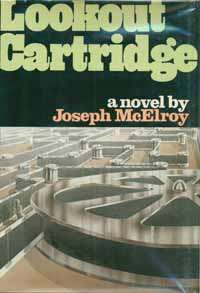Lookout Cartridge
Lookout Cartridge is Joseph McElroy's fourth novel, published by Knopf in 1974.
 Cover of the 1st edition | |
| Author | Joseph McElroy |
|---|---|
| Cover artist | Fred Marcellino |
| Language | English |
| Genre | Post-modern techno-thriller |
| Published | 1974 (Knopf) |
| Media type | Print (Hardback) |
| Pages | 531 |
| ISBN | 978-0-394-49375-6 |
The narrator, Cartwright, had made with his friend Dagger a fairly pointless art film/documentary using loaned professional equipment, with scenes set in Stonehenge, Hyde Park, and other locations in England, plus one scene in Ajaccio, Corsica. But someone destroyed it, and when acquaintances in New York press Cartwright for information about an alleged second print, the sound track, and even his personal diary, he finds himself trying to find out what really happened. Doing so involves multiple trips between New York and England, including a visit to the Hebrides and the Stones of Callanish, and increasing danger and death.
Larry McCaffery ranked Lookout Cartridge 39th in his top 100 20th-century English novels list.
Film summary
The separate scenes are:
- Bonfire in Wales - Supposedly come upon spontaneously, Cartwright's discovery that Dagger had planned it ahead of time is his first proof that there has been something sinister going on.
- Unplaced Room - Starring an anonymous US AWOL who arrived via remote Scottish islands.
- Suitcase Slowly Packed
- Hawaiian Hippie aka Hawaiian in the Underground - Bill Liliuokalani
- Hyde Park Softball
- Stonehenge
- Corsican Montage
- Marvelous Country House - With Apollo 15 on the television set being ignored.
- USAF Base
Style
The language of film, computer technology, information theory, and liquid crystals permeate the novel.
McElroy tried to make the novel as "cinematic" as possible, filled with information. The sentences were made deliberately labyrinthine, meant to be on the edge of incomprehensibility, yet to always feel as if significant clues had to be present.[1]
In the 1985 Carroll and Graf paperback reprint, McElroy wrote an introduction "One Reader to Another". He starts by stating that he recalls some French writer "arguing that fiction can't compete with film in visual immediacy." He recalls that his reaction then and in 1985 is that, "by magic ink-sign crypto-telepathy, words in the right sequence can transmit between remote minds the mind's motion pictures."
Reception
For its technical brilliance, its unremitting intelligence, for the rich complexity of the homologies and analogies between its systems and the fearful times we live in, Lookout Cartridge is the rarest kind of achievement.
— George Stade, The New York Times Book Review[2]
Spectacular, richly imagined . . . an excruciatingly difficult book to put down.
— ?, The Cleveland Plain Dealer
... a hypnagogic blowup of the metaphor of survival even if ... survival no longer seems very important.
— ?, Kirkus Reviews[3]
Very hard to read, and very much worth the effort.
— Bruce Allen, Library Journal, 2/1/1975
References
- Tom LeClair 1978 interview, in LeClair and McCaffery (eds.) Anything Can Happen (1983)
- Stade 1975.
- Kirkus Reviews 1975.
Further reading
Book Reviews
- "Lookout Cartridge". Kirkus Reviews. 1975.
- Harris, Michael (March 9, 1975). "Metaphor Man". The Washington Post Book World. p. 3.CS1 maint: ref=harv (link)
- Holmes, Carol (May 1975). "Books in Brief". Harper's Magazine: 55.CS1 maint: ref=harv (link)
- McFadden, Cyra (May 12, 1975). "More Mystification Than Mystery". The New Leader. LVIII (10): 21–22.CS1 maint: ref=harv (link)
- Nordell, Roderick (April 30, 1975). "Shuttling until time becomes a riddle". Christian Science Monitor. p. 25.CS1 maint: ref=harv (link)
- Stade, George (February 2, 1975). "Harmonies and dissonances". The New York Times Book Review. p. BR1.CS1 maint: ref=harv (link)
- Thamon, W. T. Jr. (May 3, 1975). "Current, Notable Fiction: Lookout Cartridge". The New Republic. 172 (18): 28.CS1 maint: ref=harv (link)
Literary analysis
- Johnston, John (1989). "Representation and Multiplicity in Four Postmodern American Novels". Texas Review. 10: 23–36.CS1 maint: ref=harv (link)
- reprinted in Trachtenberg, Stanley, ed. (1995). Critical Essays on American Postmodernism. G. K. Hall.
- The other three novels are Gravity's Rainbow, J R, and Ratner's Star.
The following articles appeared in the Joseph McElroy issue of The Review of Contemporary Fiction. X. 1990:
- Johnston, John. ""The Dimensionless Space Between": Narrative Immanence in Joseph McElroy's Lookout Cartridge": 95–111. Cite journal requires
|journal=(help)CS1 maint: ref=harv (link) - Campbell, Gregor. "Processing Lookout Cartridge": 112–18. Cite journal requires
|journal=(help)CS1 maint: ref=harv (link) - Buckeye, Robert. "Lookout Cartridge, Plans, Maps, Programs, Designs, Outlines": 119–26. Cite journal requires
|journal=(help)CS1 maint: ref=harv (link) - Stonehill, Brian. "Intimations of Human Divinity in Joseph McElroy's Lookout Cartridge": 127–32. Cite journal requires
|journal=(help)CS1 maint: ref=harv (link) - Siemion, Piotr. "Chasing the Cartridge: On Translating McElroy": 133–39. Cite journal requires
|journal=(help)CS1 maint: ref=harv (link)
In addition, see these general works on McElroy's fiction.